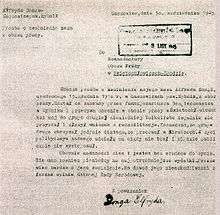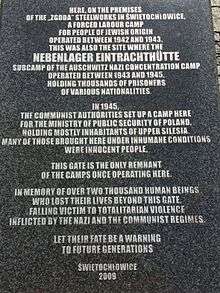Zgoda labour camp
The Zgoda labour camp (Polish pronunciation: [ˈzɡɔda]) was a concentration camp for Silesians, Germans, and Poles,[1][2] set up in February 1945 by the Soviet NKVD in Zgoda district of Świętochłowice, Silesia. It was controlled by the communist secret police until its closure by the Stalinist authorities of Poland in November of the same year.[3]

Between 1943 and January 1945 during World War II, the camp in Świętochłowice operated as German Nazi Arbeitslager. It was a labour subcamp (Arbeitslager Eintrachtshütte) or the Eintrachthütte concentration camp of the Nazi concentration camp Auschwitz. After the NKVD transfer of the facility to MBP, Colonel Salomon Morel became the commander of the renamed Zgoda camp on 15 March 1945.[3][4]
Zgoda Labour Camp operation
The Nazi German camp was evacuated by the Germans before 23 January 1945. However, its infrastructure was left intact and after a few weeks the camp was restored by the NKVD, disinfected, and repopulated in February 1945 with Silesian prisoners from Katowice, Bielsko and Nysa.[3] It continued to be used until November of the same year, under the jurisdiction of the Ministry of Public Security of Poland. It was one of several camps of this type in Silesia (the central camp was the one in Jaworzno).[1]

Following World War II, the communist authorities of Poland decided that the Silesian Volksdeutsche from the German DVL groups I and II were to be considered ethnically German. They were believed to have willingly collaborated with the Nazi regime in Upper Silesia during the war and were the subject of judiciary.[1] People who signed or were compelled to sign the Nazi lists III and IV were freed from this procedure providing they swore an oath of loyalty to the Polish state.[1] The decision to treat Silesian prisoners as Germans was motivated by prior dealings with the Volksdeutsche from the Nazi General Government, and did not take into account local conditions under which the population found themselves on DVL lists, often unwillingly.[1] The policy was changed in 1946, and the criteria were no longer based on Volksdeutsche list number, but on specific actions of individual prisoners during the Nazi occupation of Poland.[1]
About 6,000 persons were imprisoned at the Zgoda camp, 1/3 of them Germans (1,733 in August 1945 along with those from Upper Silesia).[1][5] The first inmates were sent there by militia, security services and the Soviet NKVD.[1] Some families took children with them to the camp,[1] but such cases were marginal, and concerned a few mothers who did not want to leave their children alone.[6] Statistics and witness statements speak of about 2 mothers with children below 1 to 5 years of age and perhaps 2 or 3 children 6 or 7 years old. This was a violation of a directive by Security Department that forbade admitting prisoners along with children below 13 years old, who were ordered to be handed over to state care instead.[6]
Most camp inmates were over 40 years old.[6] The majority consisted of Silesians from the Volksliste category I and II as well as ethnic Germans, with some ethnic Poles and at least 38 inmates of other nationalities.[1] Women made up 17% of the camp prisoners in June 1945, but their number went down later (from 716 to just over 300).[5][6] There was also a large group of people above 60 years old.[6] Among the incarcerated were former Nazi Party members, including those with the rank of Ortsgruppenleiter,[6] for instance several dozen Nazis from Prudnik and Głubczyce.[6] Some inmates have been sentenced by the courts for criminal acts during Nazi occupation of Poland, one was sentenced for four years for oppressing the Polish population during the war.[6]
Death toll

Documented figures show that 1,855 prisoners lost their lives at Zgoda camp from February until November 1945. Most died during the typhus epidemic, that reached its highest death toll in August,[1] claiming 1,600 victims.[7] No medical help was offered to prisoners, and no action taken, until the epidemic spread across the entire camp. The bodies of the dead were being piled up on carts at night and taken outside the camp to hastily dug out mass graves. Eventually, a medical team was sent in, which vaccinated the remaining population.[1]
The inmates were systematically maltreated and tortured by the guards including by Morel himself, who used to make pyramids of beaten prisoners (up to six layers high) causing suffocation.[1] The camp was one of the most cruel Stalinist detention facilities in Silesia where communist crimes recognized by international law as crimes against humanity were being committed against the Silesian prisoners under the command of only two men, Aleksy Krut, and Salomon Morel who was running the camp alone from June 1945.[1] Morel, a former member of the communist underground army Armia Ludowa, claimed that his family perished during the Holocaust at the hands of the Nazis.[8] He did not inform his superiors about the typhus epidemic until the news of the situation was reported by the local newspapers.[6] He notified the local prosecutor, who in response ordered that no new prisoners be sent to the camp.[6] For his negligence and for allowing the epidemic to take its toll, as well as for the failure to uphold his duties as commander of the camp, Morel was punished by a three-day house arrest and temporary reduction of pay by 50%.[6] In his defence, Morel claimed that the camp was overcrowded and most of the inmates arrived already sick, and that the camp administration left him with no means to stop the disease. His statements however, were contradicted by official records.[6] He was also reprimanded by the prosecutor for failing to send back to prison detainees who had arrest warrants issued against them, and instead keeping them in the camp.[6]
The Zgoda camp was closed in November 1945 based on general order of the Minister of Security Stanisław Radkiewicz, issued 15 September 1945. The paper instructed to resolve all cases of detention of persons without prosecutor sanctions issued upon them.[6] According to Morel, the camp was no longer needed.[1] Almost all the remaining prisoners were released.[1] However, they first had to sign an oath, under the penalty of prison, to never disclose the events witnessed in the camp.[1] For years, the history of the camp lived exclusively in the memories of its former prisoners and their families, carefully hidden for fear of repressions for revealing how the native people of Silesia were treated.[1]
After the fall of communism, Morel left Poland for Israel in 1992. He was subsequently wanted by the Polish authorities for war crimes and crimes against humanity. Poland requested his extradition twice and denied him his police pension.[9] Israel refused to extradite him. Morel died in Tel Aviv in February, 2007.[10]
References
- (in Polish) "Historia Obozu Pracy w Świętochłowicach" (History of the Labour Camp in Swietochlowice") The Institute of National Remembrance (Instytut Pamięci Narodowej, web site, accessed 2009-04-29.
- Gerhard Gruschka, Zgoda - miejsce grozy: obóz koncentracyjny w Świętochłowicach, Wokół Nas publishing, Gliwice 1998, ISBN 83-85338-74-8. (in Polish)
- The Polish Institute of National Remembrance Bulletin: "Salomon Morel and the camp at Świętochłowice-Zgoda", including Index of articles, copies of IPN documents and notes. Publication date: 21 July 2005. (in English)
- Dr. Adam Dziurok, Obóz Pracy Świętochłowice-Zgoda. Archived June 11, 2011, at the Wayback Machine Instytut Pamięci Narodowej, 2010
- Salomon Morel and the camp at Świętochłowice-Zgoda. Archived June 12, 2011, at the Wayback Machine Response by the State of Israel to the application for the extradition. Publication date: July 21, 2005. Institute of National Remembrance. Retrieved July 25, 2012.
- Salomon Morel i obóz w Świętochłowicach-Zgodzie The Institute of National Remembrance, web site accessed 2010-07-28
- Marek Klecel, "Dziedzictwo Auschwitz i Gułagu." Based on: Bogusław Kopka, Obozy pracy w Polsce 1944 - 1950. Przewodnik encyklopedyczny. Niezależna Oficyna Wydawnicza Nowa, Warszawa 2003.
- Józef Krzyk, "Komendant stalinowskich obozów bez renty," Gazeta Wyborcza, Katowice, 14 February 2006
- "Renta Morela została zawieszona." Presspublica, rp.pl/archivum.
- State of Israel Department of Internal Affairs, Rejections of Requests for the Extradition of Salomon Morel. Institute of National Remembrance. Inserts. Archived 2007-10-13.
Further reading
- (in English) John Sack, An Eye for an Eye: The Untold Story of Jewish Revenge Against Germans in 1945, Basic Books 1993, ISBN 978-0465042142.
- (in German) Alfred M. de Zayas: Die Anglo-Amerikaner und die Vertreibung der Deutschen, Ullstein, 1988, ISBN 3-548-33099-1
- (in German) John Sack: Auge um Auge, Ernst Kabel Verlag, Hamburg 1995, ISBN 3-8225-0339-8
- (in Polish) An online report by Institute of National Remembrance, including Overview, Chronology, Historical narrative, Camp layout, S.Morel, Statistics, Letters, and Documents.
- (in Polish) List of the victims
- (in German) Gerhard Gruschka: ZGODA. Ein Ort des Schreckens. ars una, Neuried 1997, ISBN 3-89391-607-5
- (in Polish) Gerhard Gruschka: Zgoda - miejsce grozy: obóz koncentracyjny w Świętochłowicach, Wokół Nas, Gliwice 1998, ISBN 83-85338-74-8
- (in German) Sepp Jendryschik: Zgoda : Eine Station auf dem schlesischen Leidensweg, 2000, ISBN 3-927933-67-8
- (in German) Franz W. Seidler, Alfred de Zayas (Hrsg.): Kriegsverbrechen in Europa und im Nahen Osten im 20. Jahrhundert, (darin Aufsatz von Helga Hirsch), Mittler Verlag, Hamburg Berlin Bonn 2002, ISBN 3-8132-0702-1
- (in Polish) Adam Dziurok: Obóz pracy w Świętochłowicach w 1945 roku (a collection of documents), IPN, Warszawa 2003, ISBN 83-915983-6-5